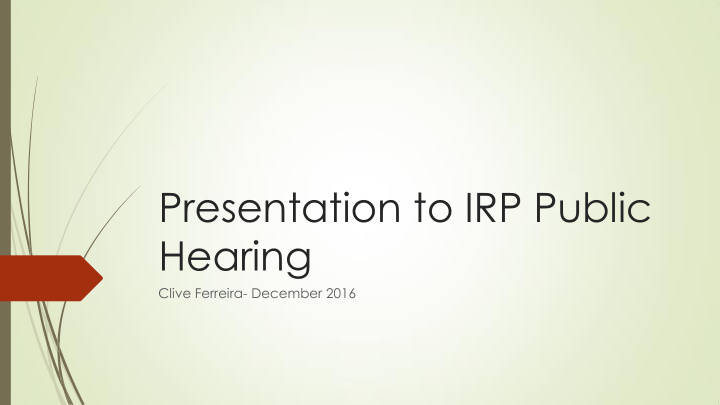



Presentation to IRP Public Hearing Clive Ferreira- December 2016
Agenda Background Comments on IRP Analysis Conclusion
Background Presenter Retired investment banker (BSc. B. Eng. (Civil), B.Com., MBA (Finance) Forty years in infrastructure as contractor, advisor and financier The last 20 years advising IPPs and electricity sector across the continent Founder Fieldstone Africa, leading African energy advisor Founder Gaia Infrastructure Partners - continues to serve as non executive director on Gaia IP and listed Gaia IC boards
Comments on IRP as it stands The IRP is probably the biggest single infrastructure planning tool in the country It has significantly more impact, sadly, than the NDP as it explicitly determines and guides electricity generation spend It is therefore one of the most important capital budgeting decisions facing this country The IRP in my view fails dismally in assisting us in making the correct decisions Although nuclear is clearly not a viable option it is being kept in the picture by Eskom and others The IRP is already dated Wrong implementation has serious and even dire consequences for the country and vice versa The IRP seems to bind us in long term inflexible central planning
South African Government Recent Debt History- Not good Expensive choices can tip South African over the edge!
Why do I reach this conclusion? Capital costs of all plant seems to be suspect Ignores Interest During Construction (IDC). Very imported for long lead time items Nuclear costs appears to be low Other plant costs are too high The capital costs are clearly dated as the ERPI assessment is dated AUGUST 2015 The IRP seems to treat risk assuming that all technologies have equal risk. This is an error Financing of choices seem to be totally ignored The ERPI document seems to assume that the whole programme is implemented by Eskom It ignores the spectacular, seemingly “inconvenient” success of the REI4P
Capital Costs Assumptions Suspect Interest during construction (IDC) appears to be ignored and coal and nuclear plants can have up to a 50% increase of total costs when IDC is included Nuclear plant costs assumed are unproven in SA. The CSIR costs for their base case that excluded nuclear were almost 30c/kwh lower, and no firm local prices for nuclear have been tabled. It is significant that even Vietnam recently aborted the so-called cheaper Russian units after seven years of negotiations. Counties like Japan, Sweden, US. Germany have curtailed their nuclear plans The assumed costs for wind and solar totally ignores the latest low prices achieved in the REI4P The latest spectacular reduction in battery prices is ignored The capital costs assumed is of October 2015 and not all technology price curves are the same
Technology Risk It is common cause that the 2010 IRP did not expect the dramatic price reductions in especially solar PV after 2011 Nuclear, after 50 years, is still not a proven private sector solution i.e. its still depends on explicit Government support even in the US The IRP needs to be designed to be more flexible and not tie us to large long-term commitments We have just learnt a very expensive lesson with Medupi and Kusile Investing in very large plants with new unproven technology and assuming the wrapping risk Why repeat the the same mistake again Why ignore the possibilities of batteries, solar roof top etc.
Financing choices Financing opportunities, restrictions, and costs seems to have been ignored Finance is not an unlimited resource, and different financial conditions pertain to different technologies; yet this is not even mentioned in IRP Energy supply is actually or should be a financial decision not a technogy choice Nuclear plants will not be funded by most financial institutions even though it will be the most costly Cheap USD funding may be offered for a nuclear build, but given our volatile currency, this could become even more costly
Private sector participation ignored The ERPI report does not mention the successful REI4P It plans the IRP from an Eskom vantage point Eskom has proven to be an unreliable supplier Eskom has a long history of making large capital budgeting mistakes Cheap cost of capital does not necessarily translate into cheap cost The REI4P has succeeded in the following: Raised more than R200bn long term funding from local and international sources Reduced tariffs significantly to below Eskom’s weighted average cost of production Despite this it created significantly BEE value and local manufacture All this was achieved without scandal
Conclusion The IRP as is cannot be used to make an important Capital Budget Commitment The IRP seems to bend over backwards to accommodate Nuclear in the face of growing evidence that it is definitely un-fundable and may cripple our country The right IRP choices can ignite the SA economy, the current one is more of the unwelcome same Eskom’s role in the execution of the IRP needs to be re -evaluated
Recommend
More recommend